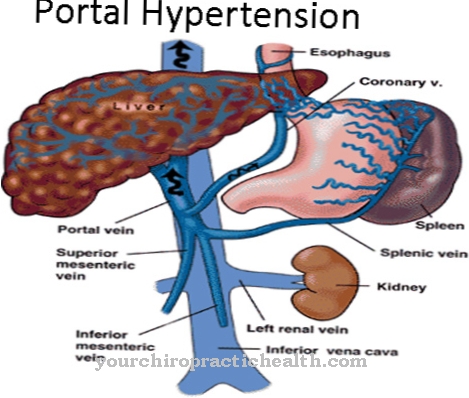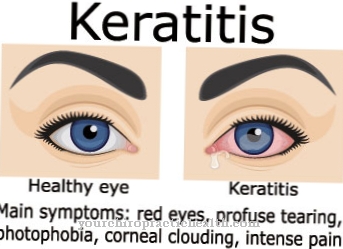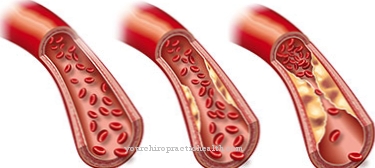The Heerfordt-Mylius Syndrome is a form of sarcoid and thus a granulomatous and immunological inflammation that mainly affects the cranial nerves. The symptoms usually resolve spontaneously. Long-term medication with immunosuppressants is only indicated if the disease becomes chronic.
What is Heerfordt-Mylius Syndrome?

© Adiano - stock.adobe.com
Patients with Heerfordt-Mylius syndrome suffer from a special form of sarcoid. This is a granulomatous inflammation that can assume subchronic to chronic dimensions. Sarcoid is often referred to as an inflammatory multi-system disease that forms small nodules in various organs and thus triggers an above-average immune response with inflammatory reactions.
The lungs are most commonly affected by inflammation. The hilar lymph nodes become inflamed in about 95 percent of cases. In principle, sarcoid can cause inflammation in any organ system. In the special form of Heerfordt-Mylius syndrome, inflammation of the cranial nerves and the connective tissue layers in the central nervous system occurs in particular.
Christian Frederick Heerfordt first described Heerfordt-Mylius syndrome in 1906, with Jonathan Hutchinson documenting sarcoid for the first time shortly before. The syndrome can be summarized as a type of neurosarcoidosis. The outbreak occurs between the ages of 20 and 40.
causes
As for all other forms of sarcoid, the causes of Heerfordt-Mylius syndrome are largely unclear. Since familial accumulation has been observed, science is currently assuming genetic factors for the outbreak of the disease. An involvement of environmental toxins has not yet been ruled out. The genetic level was demonstrated in 2005 by genetic abnormalities in patients with sarcoid.
These abnormalities are mutations that appear to affect the onset of the disease. According to current research, the mutation of just one base pair in the BTNL2 gene on chromosome six can increase the likelihood of the outbreak of the disease by up to 60 percent. This gene influences immunological inflammatory reactions and activates specialized blood cells.
If both base pairs mutate on the chromosomes, the risk of the disease increases three-fold. However, these results are vague and do not necessarily have to apply to special forms such as Heerfordt-Mylius syndrome.
You can find your medication here
➔ Medicines for paresthesia and circulatory disordersSymptoms, ailments & signs
The Heerfordt-Mylius syndrome is characterized by five main symptoms. These key symptoms include, for example, a reduction in saliva secretion by around half. Extreme dry mouth with difficulty swallowing and speech disorders set in. This form of hyposalivation is also known as xerostomia. In addition, there is usually uveitis.
The middle skin of the eyes is affected by inflammation. A foreign body sensation sets in and the flow of tears is increased. Patients also often suffer from parotitis, that is, inflammation of the parotid glands. Facial paralysis can also occur, which is usually caused by inflammation of the seventh cranial nerve.
The inflammatory reactions are accompanied by a relapsing fever. Other cranial nerves are often affected by inflammatory reactions. Apart from that, nodular inflammation can form in the meninges (meninges). Nodular inflammations sometimes develop in the mammary and gonads as well, but these are not among the main symptoms of Heerfordt-Mylius syndrome.
Diagnosis & course
As with all other sarcoidoses, the diagnosis of Heerfordt-Mylius syndrome is made depending on the respective symptoms of the complaints. Before Heerfordt-Mylius syndrome is diagnosed, patients are usually diagnosed with sarcoid. As a rule, a CT is used as an imaging method. The stage of the disease can be determined on the basis of this imaging.
The prognosis for Heerfordt-Mylius syndrome is favorable to very favorable. As a rule, the inflammation regresses through spontaneous remissions. Only in rare cases does the disease develop into a chronic course. It almost never leads to a chronically progressive course in which there is no longer any remission between attacks.
Complications
In many cases, Heerfordt-Mylius syndrome does not require treatment. The symptoms often disappear spontaneously and usually do not reappear afterwards. However, complications can also arise in a chronic course. The affected person suffers from speech disorders and dryness in the mouth. Difficulties in swallowing also occur, so that the ingestion of food and liquids cannot easily take place.
This can lead to dehydration or malnutrition. It is not uncommon for the speech disorders, especially in children, to lead to bullying or teasing. This can lead to psychological complaints and depression. Furthermore, various parts of the face are paralyzed and the patient is less able to cope with stress.
The affected person often falls ill with a fever and inflammation of the meninges occurs. These can be life-threatening for the patient. The symptoms of Heerfordt-Mylius syndrome can be treated and limited. However, it cannot be predicted whether all complaints can be completely restricted. Speech disorders can be treated and corrected in therapy. Treatment usually does not lead to any further complications or complaints.
When should you go to the doctor?
Since Heerfordt-Mylius syndrome can also irreversibly damage the cranial nerves, the syndrome should always be examined by a doctor. In most cases the syndrome will resolve on its own, but an examination is still advisable.
A doctor should then be consulted if the person concerned suffers from severe dry mouth. The patient lacks spit and there are speech disorders or swallowing difficulties. Heerfordt-Mylius syndrome also leads to a feeling of a foreign body in the eye, although there is clearly no foreign body in the eye.
A medical examination is also advisable here. In addition, paralysis in different areas of the face can also indicate Heerfordt-Mylius syndrome. A doctor should be consulted immediately, especially if this paralysis persists. Diagnosis of the syndrome can be made in a hospital or with a general practitioner. Various drugs are used in the treatment.
Doctors & therapists in your area
Treatment & Therapy
The treatment of patients with Heerfordt-Mylius syndrome depends on the symptoms and the stage of the disease. The shape of the course is also crucial. The complaints are treated symptomatically and are based on the affected organ system. As a rule, acute relapses are treated with medication with corticoids, especially with glucocorticoids such as cortisol.
The aim of treatment is to inhibit the immune system. Only in rare cases do patients receive long-term therapy with immunosuppressants. Long-term medication of this kind is only necessary for chronic forms of the disease, as the permanent inhibition of the immune system can delay attacks. Because an inhibited immune system is also associated with risks, the benefits and dangers of the medication are weighed up on a case-by-case basis.
If the inflammation of various cranial nerves results in paralysis or speech disorders and swallowing difficulties, the patient is given additional speech therapy or movement therapy. Paralysis in the face can also recede spontaneously. This is especially true if the inflammation heals after a short time and hardly any nerve tissue is destroyed. To prevent persistent hyposalivation, the patient can be given saliva substitutes that protect the oral cavity from secondary diseases such as tooth decay.
Outlook & forecast
As a special form of sarcoid, Heerfordt-Mylius syndrome has a good prognosis. The course is chronic to subchronic. There is a relatively high spontaneous healing rate, which is between 20 and 70 percent. Young people between the ages of 20 and 40 are particularly affected.It was also found that more African-Americans than the fair-skinned population developed this syndrome. However, only about five percent of all sarcoid patients suffer from Heerfordt-Mylius syndrome.
What is special about this form of sarcoid is the frequent occurrence of neurological symptoms due to cranial nerve failure. This leads to facial paralysis, which is associated with typical changes in facial expressions such as drooping corners of the mouth or incomplete eyelid closure. Taste disorders can also occur. In turn, cranial nerve failure occurs in around 50 to 70 percent of all those affected with Heerfordt-Mylius syndrome. Furthermore, the iris, parotid gland and oral mucosa are inflamed.
Sarcoid mortality is around five percent, mainly due to pulmonary dysfunction. However, this applies to all forms of the disease. How high the mortality is, especially in Heerfordt-Mylius syndrome, has not yet been verified. Irritation of the iris can pose a risk to eyesight as complications such as cataracts or vitreous opacity can occur. The heart, skin, joints, gastrointestinal tract, nerves, and upper airways should also be constantly monitored. Because the course of the disease is very variable.
You can find your medication here
➔ Medicines for paresthesia and circulatory disordersprevention
Since Heerfordt-Mylius syndrome is probably caused by a combination of genetic disposition and environmental toxins, the disease cannot be prevented.
Aftercare
In most cases, the person affected has very few follow-up measures available for Heerfordt-Mylius syndrome. First and foremost, an early diagnosis must be made so that further complications can be prevented. Only through an early diagnosis and subsequent treatment of the disease can a further worsening of the symptoms be prevented.
Heerfordt-Mylius syndrome cannot heal on its own either. With this disease, the person concerned is usually dependent on the intake of medication. If anything is unclear or if you have any questions, a doctor should always be consulted first. Furthermore, the person affected should ensure that they are taken regularly and that the dosage is correct in order to alleviate the symptoms.
Since the disease can also lead to swallowing difficulties or speech difficulties, some patients with Heerfordt-Mylius syndrome need special therapy to counteract these symptoms. Some of the exercises from these therapies can also be performed in your own home to accelerate healing.
Good oral hygiene is also important in order to prevent diseases. It cannot be universally predicted whether Heerfordt-Mylius syndrome will lead to a reduced life expectancy for those affected.
You can do that yourself
The possibilities for self-help are relatively limited with Heerfordt-Mylius syndrome, so that those affected are primarily dependent on medical treatment to alleviate the symptoms.
In the case of a chronic course, it is necessary to take medication on a permanent basis. Since Heerfordt-Mylius syndrome often leads to language problems, the person affected can counteract the language disorders through various therapies. The exercises can usually also be performed at home.
Furthermore, despite the difficulty swallowing, the person affected should ensure a healthy diet and regular drinking in order to avoid dehydration or deficiency symptoms. Caries is also a common occurrence in those affected by the syndrome, so that these complications can be avoided through regular checkups at a dentist. Parents should pay attention to regular medical examinations, especially with children.
If the patient also suffers from facial paralysis, the support of friends and relatives is often necessary in order to make the person's life more pleasant. Discussions with a psychologist or with people you trust can also help with psychological complaints.

.jpg)



.jpg)


















.jpg)



